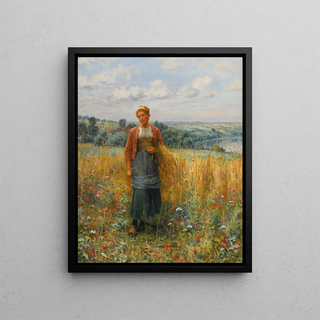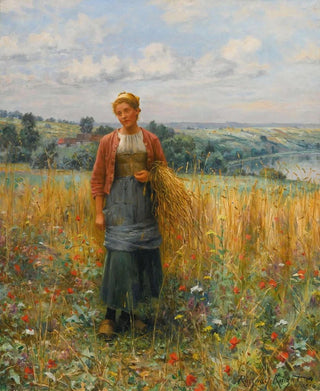Art print | Jeannine Gleaning - Daniel Ridgway Knight


View from behind

Frame (optional)
In a world where nature and humanity intertwine, "Jeannine Gleaning" by Daniel Ridgway Knight stands as a vibrant testament to the harmony between man and his environment. This artwork, imbued with poetry, reveals a bucolic scene where a young woman, immersed in her activity, embodies grace and simplicity. The painting transports us to a universe where time seems suspended, inviting the viewer to share a moment of intimacy with nature. The artist manages to capture not only the beauty of his subject but also the very essence of rural life, thus revealing an emotional depth that resonates beyond the centuries.
Style and uniqueness of the work
Daniel Ridgway Knight's style is characterized by meticulous attention to detail and masterful use of light. In "Jeannine Gleaning," vivid colors and delicate nuances blend harmoniously, creating an atmosphere that is both serene and lively. The composition, focused on the female figure, is balanced by the surrounding landscape, where each blade of grass and leaf seems to vibrate under the influence of soft, golden light. The artist excels in depicting textures, whether it is the fabric of Jeannine's dress or the natural elements around her. This artwork transcends a simple portrait to become an ode to everyday beauty, celebrating simple gestures and moments of contemplation that punctuate our existence.
The artist and his influence
Daniel Ridgway Knight, an American painter of the 19th century, is often associated with the Impressionist movement and realism. His artistic journey led him to explore the landscapes of France, where he discovered renewed inspiration in the lives of peasants and scenes of rural life. Knight's sensitivity to the beauty of nature and the human condition is reflected in his works, which capture moments of life imbued with melancholy and joy. His influence is palpable in the art world, inspiring generations of painters to embrace nature and human emotions as central subjects of their work. "Jeannine Gleaning" is a perfect

Matte finish

View from behind

Frame (optional)
In a world where nature and humanity intertwine, "Jeannine Gleaning" by Daniel Ridgway Knight stands as a vibrant testament to the harmony between man and his environment. This artwork, imbued with poetry, reveals a bucolic scene where a young woman, immersed in her activity, embodies grace and simplicity. The painting transports us to a universe where time seems suspended, inviting the viewer to share a moment of intimacy with nature. The artist manages to capture not only the beauty of his subject but also the very essence of rural life, thus revealing an emotional depth that resonates beyond the centuries.
Style and uniqueness of the work
Daniel Ridgway Knight's style is characterized by meticulous attention to detail and masterful use of light. In "Jeannine Gleaning," vivid colors and delicate nuances blend harmoniously, creating an atmosphere that is both serene and lively. The composition, focused on the female figure, is balanced by the surrounding landscape, where each blade of grass and leaf seems to vibrate under the influence of soft, golden light. The artist excels in depicting textures, whether it is the fabric of Jeannine's dress or the natural elements around her. This artwork transcends a simple portrait to become an ode to everyday beauty, celebrating simple gestures and moments of contemplation that punctuate our existence.
The artist and his influence
Daniel Ridgway Knight, an American painter of the 19th century, is often associated with the Impressionist movement and realism. His artistic journey led him to explore the landscapes of France, where he discovered renewed inspiration in the lives of peasants and scenes of rural life. Knight's sensitivity to the beauty of nature and the human condition is reflected in his works, which capture moments of life imbued with melancholy and joy. His influence is palpable in the art world, inspiring generations of painters to embrace nature and human emotions as central subjects of their work. "Jeannine Gleaning" is a perfect






